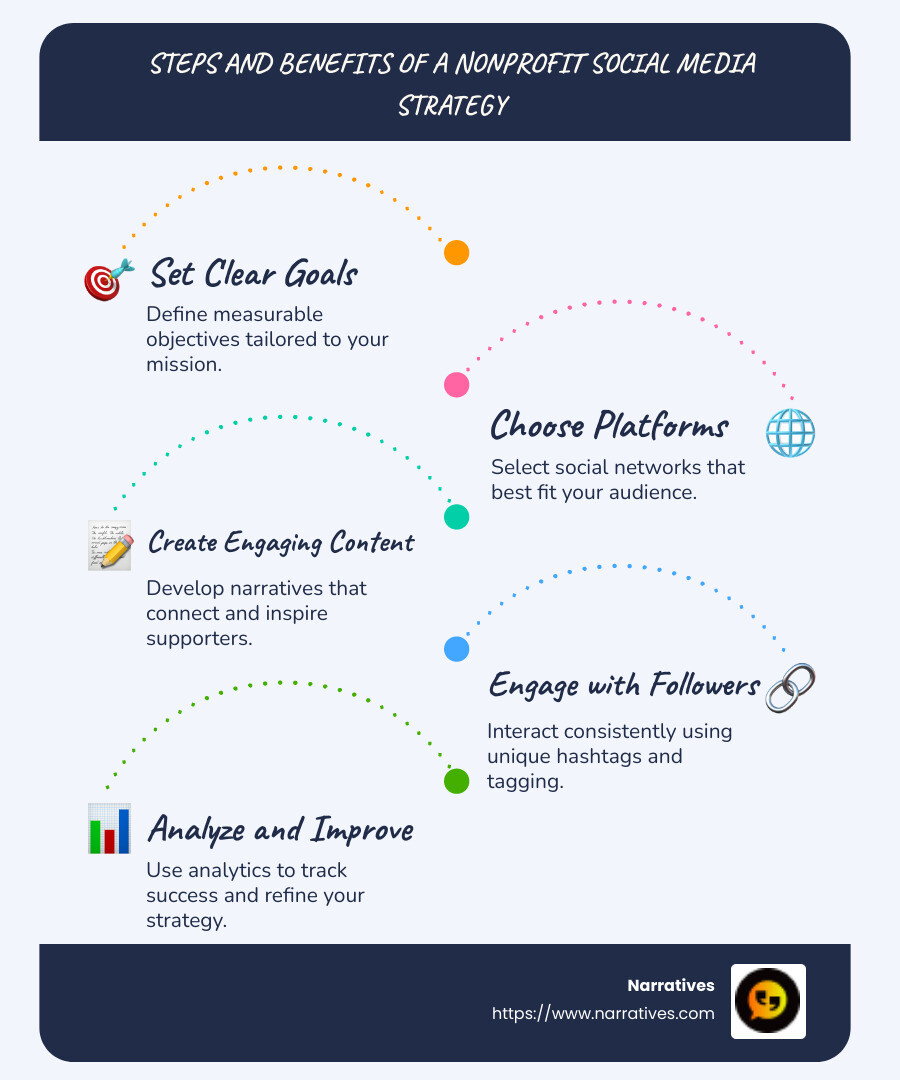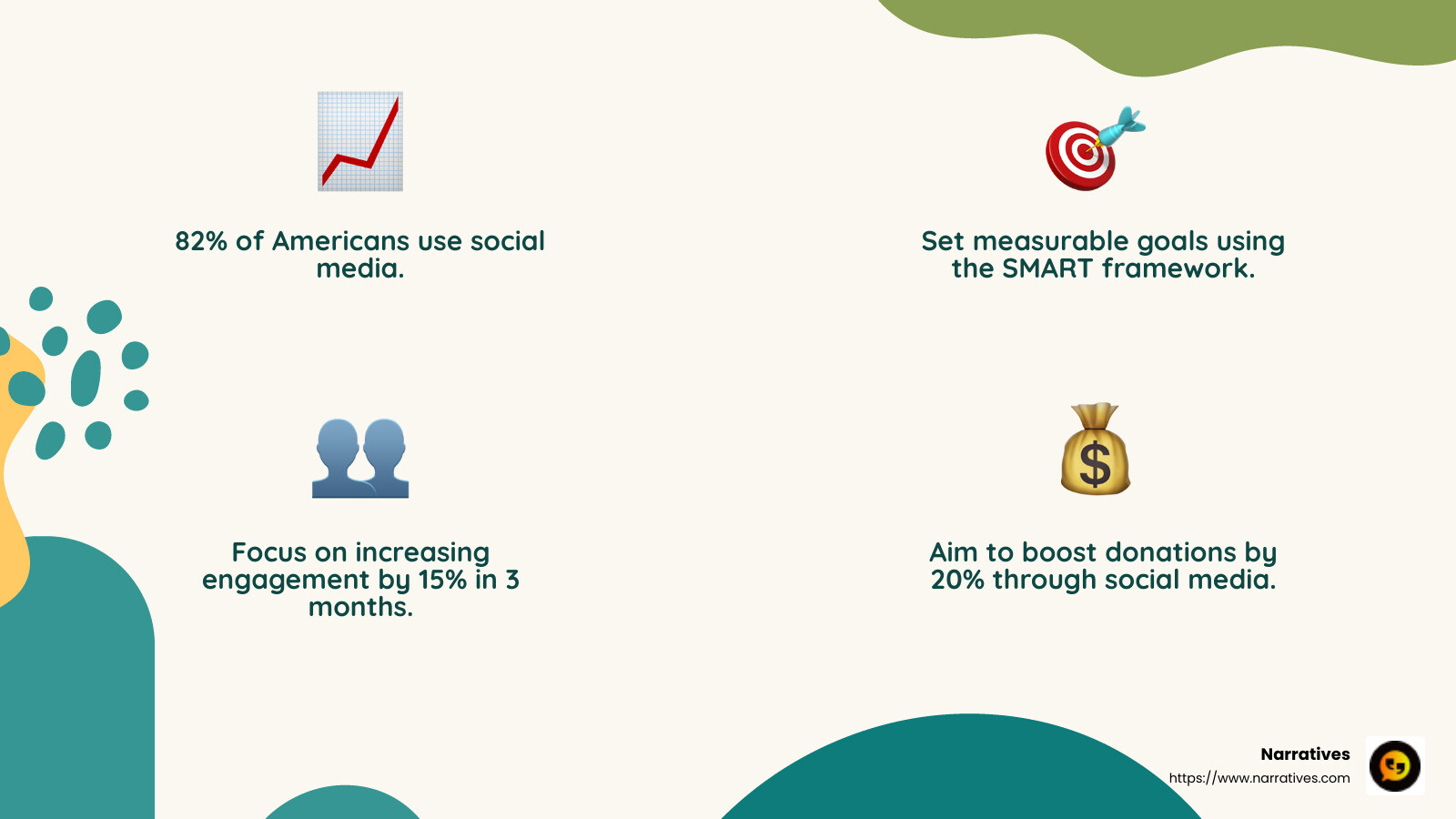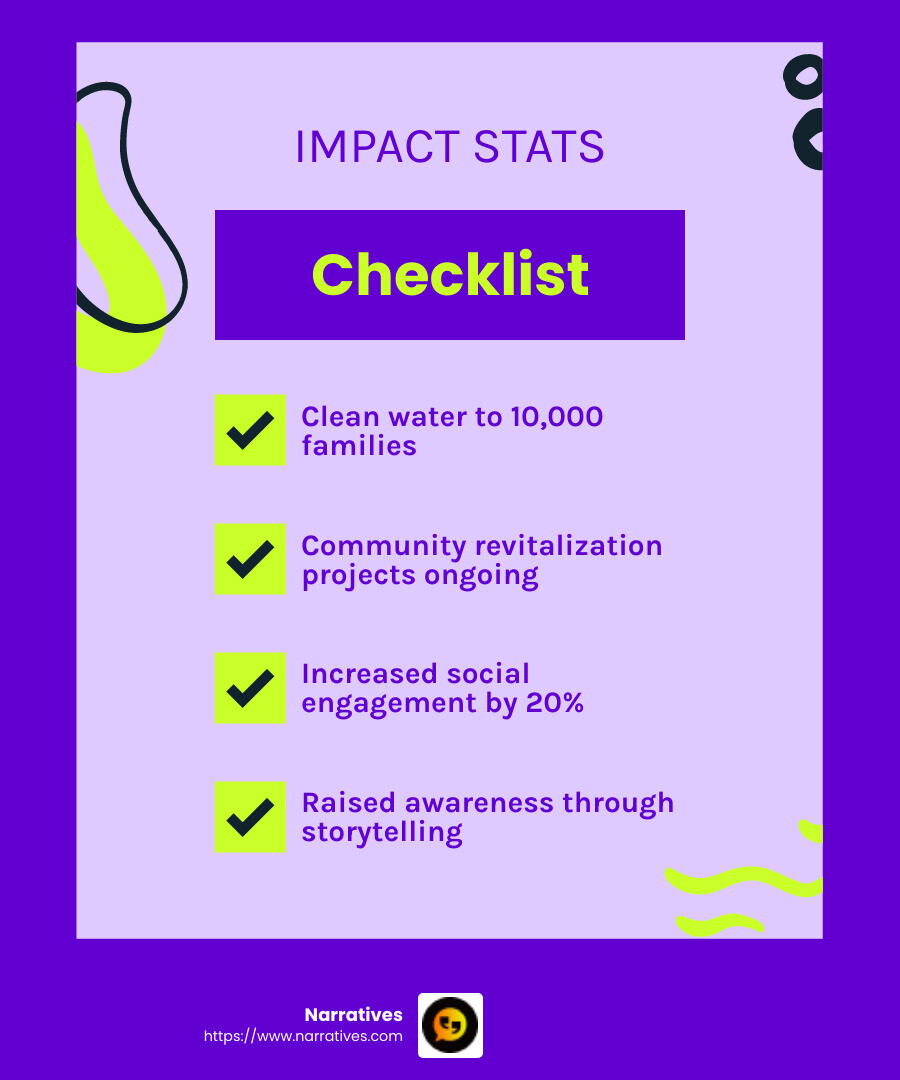Guiding Good: A Nonprofit's Social Media Strategy

Social media marketing for non profit organization is essential for amplifying your mission and reaching a broader audience, and here's why:
- Expands Visibility: Use social platforms to raise awareness about your cause and connect with more supporters.
- Engagement Opportunities: Foster interactions with your audience through compelling storytelling and meaningful content.
- Cost-Effective Promotion: Efficiently allocate limited resources for maximum impact by focusing efforts on a few major social networks.
- Performance Tracking: Measure engagement and conversions to refine strategies for better results.
For nonprofits, having an effective social media strategy isn't just beneficial—it’s indispensable. Research indicates that more than 82% of Americans use social media, and this audience is growing.
Social media allows nonprofits to tell their stories powerfully and connect deeply with supporters. Unlike traditional marketing methods, social platforms create rich opportunities to engage directly and build authentic relationships. Whether it’s raising donations or spreading crucial information, a strategic social media presence can widen your reach and strengthen your impact.
Developing your nonprofit’s social media strategy doesn't have to feel daunting. And the payoff is worth it: greater visibility, increased engagements, and improved community connections. Dive deeper into building your strategy by considering your goals, choosing the right platforms, and crafting compelling content.

Easy social media marketing for non profit organization glossary:
- social media marketing for b2b companies
- social media marketing for music artists
- social media marketing for saas
Establishing Clear Goals for Social Media Marketing for Non Profit Organization
Setting clear, measurable goals is the backbone of any successful social media marketing for non profit organization. Goals provide direction and a framework for evaluating success. Here's how to get started:
Measurable Goals
First, define what you want to achieve with your social media efforts. Goals should be specific, measurable, achievable, relevant, and time-bound (SMART). Here are some examples:
- Raise Brand Awareness: Increase social media followers by 25% over the next six months.
- Drive Website Traffic: Boost website visits by 30% from social media channels within a year.
- Improve Engagement: Achieve a 15% increase in likes, shares, and comments on posts in three months.
- Increase Donations: Generate 20% more donations through social media campaigns by year-end.

Platform-Specific Strategies
Different social media platforms offer unique opportunities and cater to various audiences. Tailor your approach for each channel to maximize impact:
Facebook: Ideal for storytelling and community building. Use Facebook Groups to foster deeper connections and encourage discussions. Use donation buttons for easy contributions.
Instagram: A visual platform perfect for showcasing impactful images and videos. Use Instagram Stories and Reels to share behind-the-scenes content and updates. Include donation stickers in Stories for fundraising.
Twitter: Best for real-time updates and engaging in conversations. Use hashtags to join larger discussions and raise awareness about your cause.
LinkedIn: Focus on professional networking and building partnerships. Share success stories and organizational achievements to attract potential collaborators.
Tip: It’s better to excel on a few key platforms than to spread your efforts too thin across many.
By setting clear goals and adopting platform-specific strategies, your nonprofit can effectively harness the power of social media to further its mission. As you implement these strategies, remember to monitor progress and adjust as needed to stay aligned with your objectives.
Creating Engaging Content
Creating engaging content is crucial for any successful social media marketing for non profit organization. The right content can amplify your message, showcase your impact, and connect with your audience on a deeper level. Here’s how to craft content that resonates:
Cohesive Content
For a nonprofit, maintaining a consistent message across all platforms is key. Your content should reflect your organization's mission and values in every post, tweet, or video. This consistency helps build trust and recognition among your audience.
Visual Branding: Use the same colors, logos, and fonts across all social media channels. This makes your content instantly recognizable.
Unified Messaging: Keep your tone and voice consistent. Whether you’re posting on Facebook or Twitter, your audience should feel like they’re hearing from the same organization.
Impact Demonstration
Showcasing the tangible impact of your work is a powerful way to engage supporters and attract new ones. Use your social media channels to highlight the difference your organization is making.
Before-and-After Stories: Share changes that have resulted from your programs. This could be a community revitalization project or a personal success story.
Statistics and Milestones: Use numbers to tell your story. For example, "In the past year, we’ve provided clean water to 10,000 families."

Human-Centric Stories
At the heart of every nonprofit is the people it serves. Human-centric stories are compelling and can create an emotional connection with your audience.
Personal Testimonials: Share stories from those who have benefited from your work. Let them tell their own stories in their own words.
Behind-the-Scenes Content: Show the faces behind your organization. Whether it’s a day in the life of a volunteer or a staff member’s story, this content can humanize your nonprofit.
Interactive Content: Encourage your audience to share their own stories related to your cause. This not only increases engagement but also builds a community around your mission.
Tip: When crafting human-centric stories, focus on authenticity and empathy. These elements are key to resonating with your audience.
By focusing on cohesive content, demonstrating impact, and telling human-centric stories, your nonprofit can create engaging content that not only captures attention but also drives action. As you develop your content strategy, remember to adapt and refine based on what resonates most with your audience.
Interacting with Followers
Engaging with followers is essential for effective social media marketing for non profit organization. Consistent interaction builds community, trust, and loyalty. Here’s how to do it right:
Consistent Interaction
Regular engagement with your audience shows that your nonprofit values its supporters. Responding to comments, messages, and mentions should be a priority.
Timely Responses: Aim to reply to comments and messages within 24 hours. Quick responses show that you care and are attentive.
Conversation Starters: Ask questions or post polls to encourage interaction. This can be as simple as "What motivates you to support our cause?"
Thank Supporters: Acknowledge and appreciate those who support your nonprofit. A simple "thank you" can go a long way in building relationships.
Tagging
Tagging is a powerful way to increase visibility and foster connections. By mentioning relevant users or organizations, you can expand your reach.
Collaborations: Tag partner organizations or influencers when sharing collaborative content. This not only acknowledges their contribution but also exposes your post to their followers.
Event Highlights: If you host events, tag attendees in your posts. This encourages them to share the content with their own networks.
Volunteer Spotlights: Recognize volunteers by tagging them in posts. Highlighting their contributions not only shows appreciation but also engages their personal networks.
Unique Hashtags
Using unique hashtags can help your content stand out and become more findable. They also create a sense of community among your supporters.
Campaign-Specific Hashtags: Create a unique hashtag for each campaign. For example, #CleanWater2023 can be used for a water conservation initiative. Encourage supporters to use it when posting about the campaign.
Event Hashtags: If you’re hosting an event, develop a hashtag that attendees can use. This makes it easy to track conversations and posts related to the event.
Branded Hashtags: Develop a hashtag that reflects your nonprofit's mission, like #EmpowerChange. Use it consistently to build brand recognition.
Tip: Monitor hashtags regularly to engage with users who are talking about your cause or campaign. This not only boosts engagement but also helps you understand how your audience is interacting with your content.
By focusing on consistent interaction, effective tagging, and unique hashtags, your nonprofit can foster a vibrant and engaged online community. This engagement is key to spreading your message and driving meaningful action.
Tracking Progress and Refining Strategy
Once you've established a solid foundation for social media marketing for non profit organization, it's crucial to track your progress and refine your strategy. This ensures you're on the right path and making the most of your efforts.
Analytics: The Compass for Your Strategy
Analytics are your best friend when it comes to understanding how well your social media efforts are paying off. Most social platforms offer built-in analytics tools that provide insights into your audience and post performance.
Audience Insights: Learn about who is engaging with your content. Are they the people you expected to reach? Use this data to adjust your target audience if necessary.
Post Performance: Identify which types of posts are resonating most with your audience. Are they more engaged with videos, photos, or stories? Use these insights to tailor your future content.
KPIs: Measuring Success
Key Performance Indicators (KPIs) are essential for measuring the success of your social media strategy. They help you quantify your goals and track your progress.
Engagement Rate: This includes likes, comments, and shares. A high engagement rate indicates that your audience is actively interacting with your content.
Click-Through Rate (CTR): If your goal is to drive traffic to your website, monitor how often people click on your links.
Conversion Rate: Track how many social media interactions lead to actual donations or volunteer sign-ups. This is a critical metric for nonprofits.
Continuous Improvement: The Path to Growth
The world of social media is always evolving. To stay relevant, your strategy should be flexible and open to change.
Regular Reviews: Dedicate time each month to review your analytics and KPIs. Identify what's working and what's not.
A/B Testing: Experiment with different types of content, posting times, and formats. This can reveal new opportunities for engagement and growth.
Feedback Loop: Encourage feedback from your followers. Use surveys or direct messages to learn what they enjoy and what they'd like to see more of.
By focusing on analytics, KPIs, and continuous improvement, your nonprofit can ensure its social media strategy remains effective and impactful. This ongoing process will help you stay connected with your audience and achieve your mission.
Frequently Asked Questions about Social Media Marketing for Non Profit Organization
How can nonprofits use social media to increase awareness?
Nonprofits can leverage social media to significantly boost awareness by sharing impactful stories and engaging content. Here are some key strategies:
Storytelling: Share human-centric stories that highlight the impact of your mission. For example, spotlight a volunteer's journey or the change of a beneficiary. Visual platforms like Instagram are perfect for this.
Engagement: Actively interact with your audience. Respond to comments, answer questions, and encourage discussions. This not only builds relationships but also expands your reach as engaged users often share content.
Influencers: Collaborate with influencers who align with your cause. They can help amplify your message to a broader audience, especially if they have followers who are passionate about similar issues.
What are the best social media platforms for nonprofits?
Choosing the right platform is crucial for effective social media marketing for non profit organization. Each platform has its strengths:
Facebook: Ideal for reaching a wide audience with diverse age groups. Use it for event promotions and fundraising campaigns.
Instagram: Great for visually showcasing the impact of your work. Use stories and reels to engage with a younger audience.
X (formerly Twitter): Perfect for real-time updates and engaging in conversations. Use hashtags to join broader discussions.
LinkedIn: Best for professional networking and sharing thought leadership content. Engage with other nonprofits and industry experts.
How do nonprofits measure social media success?
To measure the success of your social media efforts, focus on specific metrics that align with your goals:
Engagement Metrics: Track likes, comments, and shares to gauge how well your content resonates with your audience.
Website Traffic: Use tools like Google Analytics to see how much traffic is coming from social media platforms.
Conversion Rate: Measure how many social media interactions lead to tangible actions, such as donations or volunteer sign-ups.
By focusing on storytelling, selecting the right platforms, and measuring success through key metrics, nonprofits can effectively use social media to further their mission and increase their impact.
Conclusion
Narratives is more than just a content agency; we are your partner in crafting stories that resonate and inspire action. Our focus on digital storytelling allows nonprofits to share their unique impact stories in a way that not only builds trust but also amplifies their reach and visibility.
Community-driven storytelling is at the heart of what we do. By elevating underrepresented voices, we help organizations connect deeply with their audiences and foster a sense of community and belonging. This approach not only highlights the struggles and triumphs of those you serve but also invites others to join your mission.
Using platforms like Instagram and Facebook, we work with nonprofits to create high-quality, emotionally resonant multimedia content. This content is designed to engage, inform, and inspire your audience to take meaningful action, whether it's donating, volunteering, or simply spreading the word.
By partnering with us, you're not just sharing stories; you're building a movement. Visit our Media Network Services to explore how we can help you tell your story and make a difference.
Together, let's guide good and change the world, one story at a time.


